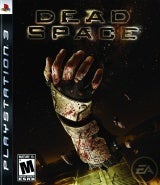Since its announcement last fall, EA's Dead Space has made some big waves.
We'll dispense with the background and niceties about the plot and get down to the nitty gritty. In the future, Earth's resources are scarce, and humanity survives by sending mining ships around the galaxy to strip the elements from other planets. As space miner Isaac Clarke, you're aboard the Nishimura, a massive mining ship that's gone AWOL and offline. Naturally, after you board the ship with fellow employees, things go decidedly pear-shaped.
We've discussed the numerous gameplay quirks, such as zero-gravity combat and "strategic dismemberment," EA's coined term to describe gunplay. But we haven't been able to sit down and spend more than a matter of minutes with it until now. We're less than a month off from Dead Space's release, so nearly everything we've played should be indicative of what you'll experience in mid-October. We'll spare you spoilers and plot details, but as of now, we're playing the fifth of 12 chapters, and will probably keep playing until the build stops us.
It might not seem apparent from the offset, but the first few chapters of the game indicate that it breaks down its twelve chapters into tasks (get the dead ship's tram running, fix the fuel boosters to prevent it from hitting an asteroid cluster, etc.). This seems appropriate, considering the way that EA's pushing Isaac as a working-class guy, or at least as working-class as you can get in outer space. EA Redwood Shores has acknowledged that Dead Space has a lot of buttons to keep you busy, and during big media events such as E3 and Games Convention it's been tough to really get comfy with the controls, especially since Isaac's movements take some time to sink in. You'll be pleased to know that the game eases you into your initial battles with the Necromorphs, undead monsters that incessantly pursue you.
We can't speak for how the remaining two-thirds of Dead Space will perform, but it's intriguing to see the ways that EA Redwood Shores lures you in. You'll be afforded certain rookie mistakes, so if you're a mediocre shot, you can get away with a few crappy misfires from your plasma cutter, a basic mining tool that can sever Necromorph parts. You'll discover the laser trail that leads you from one objective to the next (it reminds us of a high-tech version of Fable II's touted "breadcrumb trail"), and it's a subtle but great gameplay addition. We're also fans of the audio and communication logs; they're effective because they're slightly reminiscent of BioShock's audio logs, but the hologram presentation gives them more impact within the setting. Since the game does a great job easing you in with these niceties, it's a bit shocking a few chapters later as Dead Space begins to take things away.
Strategic dismemberment is easier done than said in the early chapters, but around the fourth chapter the pinch begins. We noticed fewer ammo drops for weapons that we'd grown accustomed to using. As new enemies, such as spider-like creatures that crawl into Isaac's armor, started to grow in number, we had to use other weapons such as the flamethrower. By the time we escaped the brutality of the fourth chapter, we discovered just how intricately Dead Space's gameplay hooks you, then plays with you as much as you play with it. Because in-game commerce is so quirky, your weapon and armor investments have quite a profound effect on how you'll play. Or, how badly you might screw yourself over.





